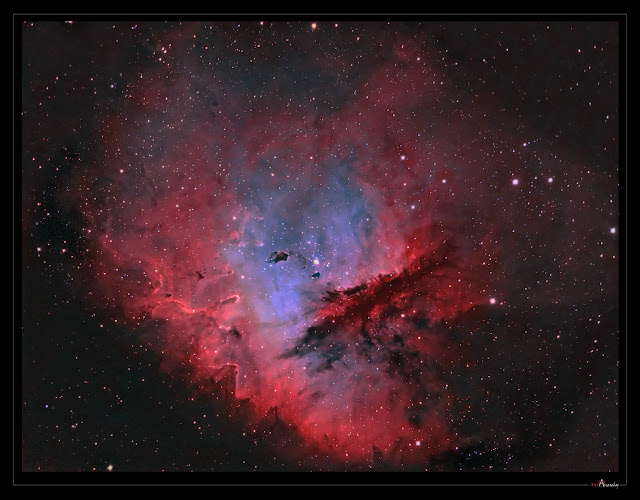COPYRIGHT, PLEASE NOTE
All the material on this website is copyrighted to J-P Metsavainio, if not otherwise stated. Any content on this website may not be reproduced without the author’s permission.
Have a visit in my portfolio
PORTFOLIO:https://astroanarchy.zenfolio.com/
Tuesday, August 30, 2011
NGC 2070, the "Tarantula Nebula", reprocessed
Since my processing technique gets better and the time of year doesn't give any support, I have reprocessed some older images. There is now star colors added and other processing is tweaked too.
The Tarantula Nebula, in Dorado
Ra 05h 38m 38s Dec -69° 05′ 07″
NGC 2070 in HST-palette
from the emission of ionized elements, R=Sulfur, G=Hydrogen and B=Oxygen.
I redid the processing and composition for this southern target. Original version, with wider field, can be seen here: http://astroanarchy.blogspot.com/2010/09/ngc-2070-tarantula-nebula.html
Tarantula nebula, NGC 2070, also known as 30 Doradus, is an ionized Hydrogen region in the Large Magellanic cloud, visible in southern hemisphere. Distance from Earth is about 160.000 light years,
it's the most active and largest starburst region known in local group of galaxies.
Image is taken with a Northern Galactic groups remote telescope in Australia.
Image is taken with a Northern Galactic groups remote telescope in Australia.
Natural color composition from the emission of ionized elements, R=80%Hydrogen+20%Sulfur, G=100%Oxygen and B=85%Oxygen+15%Hydrogen to compensate otherwise missing H-beta emission.
This composition is very close to a visual spectrum.
The telescope and technical information:
16" RCOS ja Apogee U9000 camera.
LRGB combo.
H-alpha 5x1200s, Dark and artificial Flat calibrated.
2 x O-III 1200s and 5 x 900s Dark and artificial Flat calibrated.
2 x S-II 1200s, Dark and artificial Flat calibrated.
Raw data is shared with "Team Finland"
Processing workflow:
Image acquisition, MaxiDL v4.xxx
Stacked and calibrated in CCDStack.
Deconvolution with a CCDSharp, 30 iterations added 50% to non convoluted data
Levels, curves and color combine in PS CS3.
Labels:
Narrowband color images,
nebula
Monday, August 29, 2011
Astro Anarchy gets published
The Daily Mail has used my image of NGC281, the "Pac-Man Nebula" in its article
The very same image was selected as an APOD, (Astronomy Picture of the Day) by the NASA at August 25.
Original blog post, with more images and technical details, can be seen here:
Labels:
publications
M16, the "Eagle nebula", reprocessed
Since my processing technique gets better and the time of year doesn't give any support, I have reprocessed some older images. There is now star colors added and other processing is tweaked too.
Merssier 16, in Serpens
Ra 18h 18m 48s Dec -13° 49′ 00″
M16, narrow band HST-palette and a broad band RGB-stars.
Buy a photographic print from HERE
Buy a photographic print from HERE
This is a reprocessed closeup image of the "Eagle Nebula", M16, NGC6611, in constellation Serpens.
Messier 16 is a part of a diffuse H II emission nebula region, IC 4703 at distance of about 6.500 light years.
The region is under an active star formation. The tower of gas, seen middle Right in this image, is approximately 100 trillion km long. (60 trillion miles) The longest of the "pillars" is about seven light years long.
Tips of the pillars are "stellar nurseries", there are several, recently (~one million years ago) formed young stars.
Images are taken with the Northern Galactic group's remote telescope in Australia, from Oulu, Finland. .
Natural color composition from the emission of ionized elements, R=80%Hydrogen+20%Sulfur, G=100%Oxygen and B=85%Oxygen+15%Hydrogen to compensate otherwise missing H-beta emission. This composition is very close to a visual spectrum. Broad band RGB-stars.
Buy a photographic print from HERE
Technical details
16" RCOS ja Apogee U9000 camera.
LRGB combo.
H-alpha 5x1200s, O-III 2x1200s, S-II 2x1200s . Dark and Flat calibrated.
Broad band luminance 15x300s.
RGB-colors Red 2x300s, Green 2x300s and Blue 2x300s.
Raw data is shared with Petri Kehusmaa and J-P Metsavainio
Processing workflow:
Image acquisition, MaxiDL v4.xxx
Stacked and calibrated in CCDStack.
Deconvolution with a CCDSharp, 30 iterations.
Levels, curves and color combine in PS CS3.
An experimental version of M16, narrow band colors with the broad band luminance.
HST-palette colors with a Broad band luminance and RGB-Stars.
Red=S-II, Green=H-a and Blue=O-III
Buy a photographic print from HERE
Natural color narrow band composition with a Broad band luminance and RGB-Stars.
Red=70%Ha+30%S-II, Green=O-III and Blue=70%O-III+30%H-alpha.
In this experimental image, I have tested the method to use a clear filter luminance with a narrow band color. This is (only?*) scientifically correct method to use a luminance image with a narrow band colors, since the broad band luminance contains all the wave lengths used for color information.
I don't usually like to mix colors from a different imaging methods, like pure RGB and narrow band. In this case I have used RGB, real color, stars with an emission line image.
I don't usually like to mix colors from a different imaging methods, like pure RGB and narrow band. In this case I have used RGB, real color, stars with an emission line image.
Some astro imagers tend to use H-alpha channel as a luminance, due the higher details and better S/N than any other channel has. Even though the visual appearance might look better, other channels, O-III and S-II, has no information in H-a luminance and all details in there are lost!
(*I have to point out, I use H-a luminance with a many NB images but H-a is boosted with all the information in O-III and S-II channels used. I call this method "Tone Mapping". Step by step instructions can be found here: http://astroanarchy.blogspot.com/2009/04/neaic.html )
Labels:
Narrowband color images,
nebula
Thursday, August 25, 2011
APOD
![[nasa-large.jpg]](https://blogger.googleusercontent.com/img/b/R29vZ2xl/AVvXsEhnPTKmnidt6gHuVkChO_MPYTqp2lSu-Tr0If3ey1qfJxF9BJpDhG8wIWnxo86hb3vT5OYKiznVUminjBaRRat99o70A1ODvDjHEDHpKGWYCsnjn-WFYunaGVPsfXiizriH0upX9hbpNWs/s1600/nasa-large.jpg)
-
My Image of the "Pac man Nebula", NGC281, was selected as an "Astronomy Picture of the Day" by the NASA.
You can see the NASA page here: http://apod.nasa.gov/apod/ap110825.html
You can see the NASA page here: http://apod.nasa.gov/apod/ap110825.html
-
This was my Fourth APOD, previous ones can be seen here:
Potrait of NGC281
Original blog post, with the technical details and more images, can be seen here:
Subscribe to:
Posts (Atom)

















